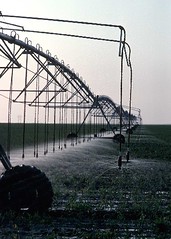 Image by eutrophication&hypoxia via FlickrIf you're reading this then you're probably already aware that I've added a new lesson to the site: Crop Circles 2. Apart from what you can find on the lesson's page, I thought I'd add some more background on the process of creating these activities.
Image by eutrophication&hypoxia via FlickrIf you're reading this then you're probably already aware that I've added a new lesson to the site: Crop Circles 2. Apart from what you can find on the lesson's page, I thought I'd add some more background on the process of creating these activities. First of all, I'm not a farmer; although I have to admit there's something about it that I find appealing. Central-pivot irrigation systems have proven to be a gold mine of content for my site. They are literally dripping with math (pun intended). This is the second lesson where they are the topic and I have two more in mind for them as well. I may try to toss out Crop Circles 3 in the next few weeks since I already have some locations scouted in Google Earth. The content for that was going to be in Crop Circles 2 but I thought it would be too large. Number 4 will probably go under a different title. That one is an ambitious project-based learning activity that I will probably work on over the summer.
A key criteria for topics in Real World Math is that they be visually appealing in Google Earth. I think most people who have viewed central-pivot irrigation from an airplane are a bit fascinated by them. Once I have the topic in mind, I need to cruise Google Earth for some good locations. There are thousands of these fields across the U.S., but there are large concentrations in Washington, Nebraska, Kansas, and Texas. Once I find some with clear views at different altitudes I begin to drop some placemarks.
Now for the Math. I already used these for word problems with circle area and circumference in the original Crop Circle's lesson. At that time I had the idea of finding the area of each ring in the field but that seemed too tedious of a calculation. That's basically how I decided the new lesson would use spreadsheets. I needed to find some relevant math content and so I began probing the internet for more information. There are a few sites and pdf files available but I couldn't find exactly what I wanted to know: how do they regulate the flow for each ring? I wanted some specific numbers because I always try to base my material on, well..., real world math. In the end I tried emailing some of the manufacturers of these irrigation systems. To my delight, I received prompt replies from Reinke, T-L Irrigation, and Roberts Irrigation, some of the top producers in the country. Most of the numbers they supplied me with are incorporated into the lesson.
In the end, I spend the most time creating and formatting the material for teachers. I try to check my work very carefully because I don't want to put out incorrect information or mistakes. It's quite fulfilling when I've finished and get to share it with you. Even more so if I get feedback. Please don't hesitate to contact me if you have any problems or questions. Let me know if you'd like me to target a particular grade level or subject. As always, I hope you find this useful.

No comments:
Post a Comment